FILE - In this May 20, 2017, file photo, a spectator takes a photo of a United States flag as it is unveiled for the national anthem as part of Military Appreciation Day before a baseball game between the Atlanta Braves and the Washington Nationals in Atlanta. The anthem has been a standard part of U.S. sports games since World War II. Experts say Game 1 of the 1918 World Series between the Boston Red Sox and the Chicago Cubs helped pave the way. The song became the official national anthem in 1931. (AP Photo/David Goldman, File)
The Associated Press
CHICAGO (AP) - On Tuesday afternoon, the crowd at Wrigley Field will be asked to stand and "gentlemen" reminded to remove their caps for the playing of "The Star-Spangled Banner." Fans who can recite the words as easily as the alphabet will sing or listen to the story of a flag that continued to wave throughout one of the most famous battles in American history.
What they may not know is that Francis Scott Key, apparently better at lyrics than melody, put his description of the battle of Fort McHenry to an old English tune that had a lot less to do with patriotism than it did with booze and women. Or that this year marks the 100th season since the song was played for the first time at a World Series game - an event that helped cement it in the national consciousness and become the national anthem that is now simply assumed to be part of game day in American sports, from Little League to the Super Bowl to medal ceremonies at the Olympics.
"Certainly the outpouring of sentiment, enthusiasm, and patriotism at the 1918 World Series went a long way to making the (song) the national anthem," said John Thorn, Major League Baseball's official historian.
On Sept. 5, 1918, newspapers were dominated by news of World War I, including the latest American dead. In Chicago, one of the headlines read, "Chicagoans on the List," and it was a particularly harrowing moment in the city for another reason: Someone, possibly self-proclaimed anarchists and labor activists, had the day before tossed a bomb into a downtown federal building and post office, killing four people and injuring dozens more.
The World Series was in town, with the Cubs hosting Babe Ruth and the Boston Red Sox. The Chicago games were played at Comiskey Park, the home of the White Sox, instead of their new home at Wrigley Field, what was called Weeghman Park at the time, because it held more fans. But in a city jittery over the bombing and weary from the war, Game 1 that day attracted fewer than 20,000 fans, the smallest World Series crowd in years.
When they got there, they didn't make much noise, though that could have had something to do with the 1-0 masterpiece Ruth was pitching - yes, pitching - for the Red Sox.
"There was no cheering during the contest, nor was there anything like the usual umpire baiting," reported one Boston newspaper.
Then, in the seventh inning, a band from the Navy training station north of Chicago started to play "The Star-Spangled Banner."
The song had been played before at major league games, from at least 1862 and on opening day in 1897, in Philadelphia, Thorn said. But this time, reported The New York Times, something happened that was "far different from any incident that has ever occurred in the history of baseball."
Players took off their caps as they faced a flag that fluttered atop a pole in right field as the 12-piece band began to play.
All of them except Red Sox infielder Fred Thomas .
Thomas was in the Navy during the series - he played on the team fielded by the Great Lakes station that was also home to the band - but was granted furlough so he could play. When the Wisconsin native heard the music, "he turned toward the flag, kept his hat on and gave a military salute," said Jim Leeke, author of "From the Dugouts to the Trenches: Baseball During the Great War."
A few fans began to sing. Then others joined in "and when the final notes came, a great volume of melody rolled across the field," the Times reported. And when it ended, "onlookers exploded into thunderous applause and rent the air with a cheer that marked the highest point of the day's enthusiasm." The Red Sox went on to win the game and the series, part of a Cubs' championship drought that ended up lasting 108 years but was a mere decade old in 1918.
Not everyone thought what happened was a big deal. Chicago sportswriter Ring Lardner mentioned it, but only as a punch line as he reported that Thomas had stood at attention three times during the game, once during the anthem and twice when the umpire was calling him out on strikes.
The leader of the Navy band at the time was conductor and composer John Philip Sousa. He was not at the game, but had recently arranged the standardized version of the song that is still played today The 1918 World Series would have been one of the first times the band could test drive the new version, according to Mike Bayes, senior chief musician for the Navy Band in Washington.
"It was a very important thing for him to put the anthem on a national stage in its new form," Bayes said.
It wasn't until 1931 that Congress and President Herbert Hoover officially designated the song as the national anthem. Still, it was clear the song was on its way after that day in Chicago.
For one thing, it was played when the series got back to Boston. And as one story goes, Red Sox owner Harry Frazee was so impressed with the way the song quieted rowdy fans that the next season that he ordered the band to play it while the flag was presented on the field.
"It was a turning point and from then on it was played at all opening days and World Series games," Leeke said.
The song was played just on holidays or special occasions for years, in part because ballparks didn't have the kind of sound systems they do today and owners were loath to pay for a band more than they had to. It wasn't until the 1940s during World War II that major league teams started playing it every day. Ironically, Cubs owner P.K. Wrigley decided the song would be played only on major holidays and for special events.
"Wrigley thought it cheapened the anthem to play it every day," said Marc Ferris, author of "Star-Spangled Banner: The Unlikely Story of America's National Anthem." In 1967, the Cubs put the song on the daily playlist, a patriotic gesture during yet another war, this one in Vietnam.
On a recent day at Wrigley, fans stood as one for the anthem.
"It still sends a chill down my back," said 90-year-old Victor Holliday of Champaign, Illinois, his time as a Marine during World War II written right there on his red cap.
The respect for the song was not lost on his son, who recalled the Vietnam war era when the anthem was not always warmly received.
"It changed radically after 9/11," said Shawn Holliday, 58. "And even today, with so many differences in the country, so much division, I think we again are falling back for comfort on these kinds of symbols."
And if anyone did not show the proper respect for the song, others in the stadium were ready.
"Come on, they can cool it for a minute and a half and put down their phones," said Wayne Messmer, who has sung the anthem nearly 5,000 times over more than three decades of performing, most notably before Cubs games at Wrigley. "I will stare people down if they are talking when I'm singing."
___
AP 360 degree video of an anthem at Wrigley Field: https://www.youtube.com/watch?v=xi7H5GnTGaQ&feature=youtu.be
___
More AP baseball: https://apnews.com/tag/MLBbaseball
FILE - In this Oct. 28, 2016, file photo, a giant United States flag is displayed during the national anthem before Game 3 of the Major League Baseball World Series between the Cleveland Indians and the Chicago Cubs in Chicago. The anthem has been a standard part of U.S. sports games since World War II. Experts say Game 1 of the 1918 World Series between the Boston Red Sox and the Chicago Cubs helped pave the way. The song became the official national anthem in 1931. (AP Photo/Chris Carlson, File)
The Associated Press

FILE - In this Aug. 24, 2014, file photo, South Korea lines the third baseline and Chicago lines the first baseline at Lamade Stadium during the national anthem before the Little League World Series Championship baseball game in South Williamsport, Pa. The anthem has been a standard part of U.S. sports games since World War II. Experts say Game 1 of the 1918 World Series between the Boston Red Sox and the Chicago Cubs helped pave the way. The song became the official national anthem in 1931. (AP Photo/Gene J. Puskar,File)
The Associated Press

FILE - In this May 25, 2014, file photo, fans watch as four L-39 Albatros high-performance jet trainer aircraft flown by the Black Diamond Jet Team, a civilian-owned aerobatic jet team, perform a fly-over during the national anthem before the Indianapolis 500 IndyCar auto race at the Indianapolis Motor Speedway in Indianapolis. The anthem has been a standard part of U.S. sports games since World War II. Experts say Game 1 of the 1918 World Series between the Boston Red Sox and the Chicago Cubs helped pave the way. The song became the official national anthem in 1931. (AP Photo/Tom Strattman, File)
The Associated Press
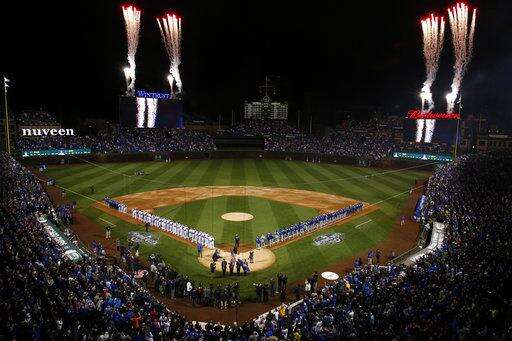
In this April 10, 2017, photo, fans and players stand as they watch fireworks during the national anthem in the opening ceremonies during home opening ceremonies before a baseball game between the Chicago Cubs and the Los Angeles Dodgers in Chicago. The anthem has been a standard part of U.S. sports games since World War II. Experts say Game 1 of the 1918 World Series between the Boston Red Sox and the Chicago Cubs helped pave the way. The song became the official national anthem in 1931. (AP Photo/Nam Y. Huh)
The Associated Press
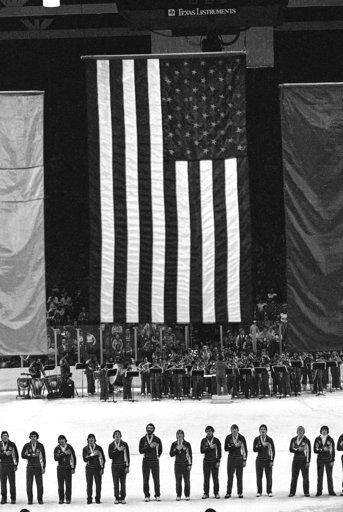
FILE - In this Feb. 24, 1980, file photo, members of the USA ice hockey team stand on ice in the arena in Lake Placid, N.Y., with hands across their chests during the playing of the national anthem at awards ceremonies. The U.S. team won the gold medal in Olympic ice hockey, the first time since 1960. Their achievement came when they defeated Finland, 4-2, earlier in the day. The anthem has been a standard part of U.S. sports games since World War II. Experts say Game 1 of the 1918 World Series between the Boston Red Sox and the Chicago Cubs helped pave the way. The song became the official national anthem in 1931. (AP Photo, File)
The Associated Press

FILE - In this Oct. 16, 1968, file photo, extending gloved hands skyward in racial protest, U.S. athletes Tommie Smith, center, and John Carlos stare downward during the playing of "The Star-Spangled Banner" after Smith received the gold and Carlos the bronze medal in the 200 meter run at the Summer Olympic Games in Mexico City. Australian silver medalist Peter Norman is at left. Smith and Carlos each wore a black glove and raised a fist in the air during the medal ceremony as a sign of solidarity with those fighting for greater equality, which some dubbed as radical and an endorsement of the black power movement. (AP Photo/File)
The Associated Press
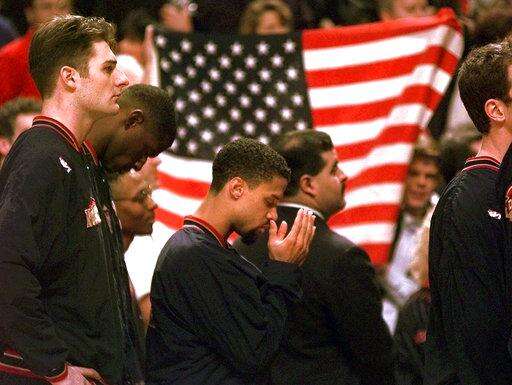
FILE - In this March 15, 1996, file photo, Denver Nuggets guard Mahmoud Abdul-Rauf stands with his teammates and prays during the national anthem before an NBA basketball game against the Chicago Bulls in Chicago. This was Abdul-Rauf's first game back since he was suspended by the NBA on March 12, 1996, for refusing to participate in the national anthem pre-game ceremony. The anthem is played before the start of every U.S. major sporting event, where fans and players are expected to salute the flag by placing a hand over the heart while singing along. Not doing so is considered unpatriotic by some. The anthem has also been used by athletes as a way to protest. (AP Photo/M. Spencer Green, File)
The Associated Press
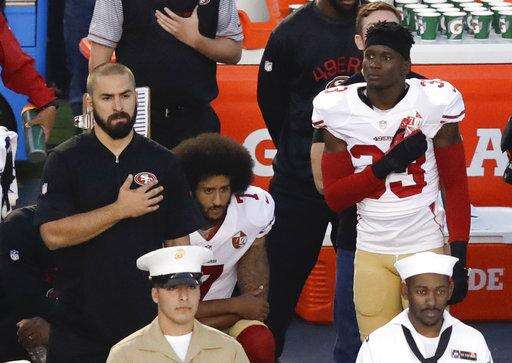
FILE - In this Sept. 1, 2016 file photo, San Francisco 49ers quarterback Colin Kaepernick, center, sits during the national anthem before an NFL preseason football game against the San Diego Chargers in San Diego. The anthem is played before the start of every U.S. major sporting event, where fans and players are expected to salute the flag by placing a hand over the heart while singing along. Not doing so is considered unpatriotic by some. The anthem has also been used by athletes as a way to protest. Kaepernick recently refused to stand when the anthem was played during NFL games, citing police brutality against black people and other forms of racial injustice. (AP Photo/Chris Carlson, File)
The Associated Press

FILE - In this Feb. 23, 2003 file photo, Manhattanville College guard Toni Smith, third from left, turns her back on the American flag during the playing of the national anthem before a basketball game between Smith's team, the Manhattanville Valiants and Stevens Tech from New Jersey, at Manhattanville College in Purchase, NY. The anthem is played before the start of every U.S. major sporting event, where fans and players are expected to salute the flag by placing a hand over the heart while singing along. Not doing so is considered unpatriotic by some. The anthem has also been used by athletes as a way to protest. (AP Photo/Stuart Ramson, File)
The Associated Press

FILE - In this Sept. 11, 2017 file photo, from left, Miami Dolphins' Jelani Jenkins, Arian Foster, Michael Thomas, and Kenny Stills, kneel during the singing of the national anthem before an NFL football game against the Seattle Seahawks in Seattle. The anthem is played before the start of every U.S. major sporting event, where fans and players are expected to salute the flag by placing a hand over the heart while singing along. Not doing so is considered unpatriotic by some. The anthem has also been used by athletes as a way to protest. (AP Photo/Stephen Brashear)
The Associated Press
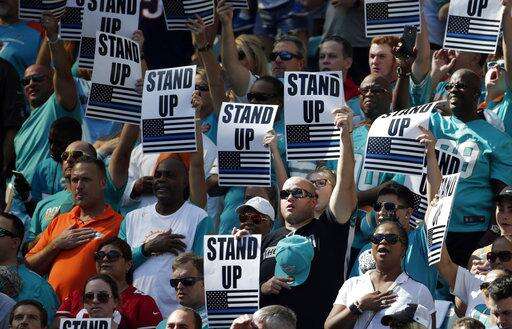
FILE - In this Nov. 27, 2016, file photo, fans show how they feel about players that don't stand for the National Anthem, during the first half of an NFL football game between the Miami Dolphins and the San Francisco 49ers in Miami Gardens, Fla. The anthem is played before the start of every U.S. major sporting event, where fans and players are expected to salute the flag by placing a hand over the heart while singing along. Not doing so is considered unpatriotic by some. The anthem has also been used by athletes as a way to protest. (AP Photo/Lynne Sladky, File)
The Associated Press